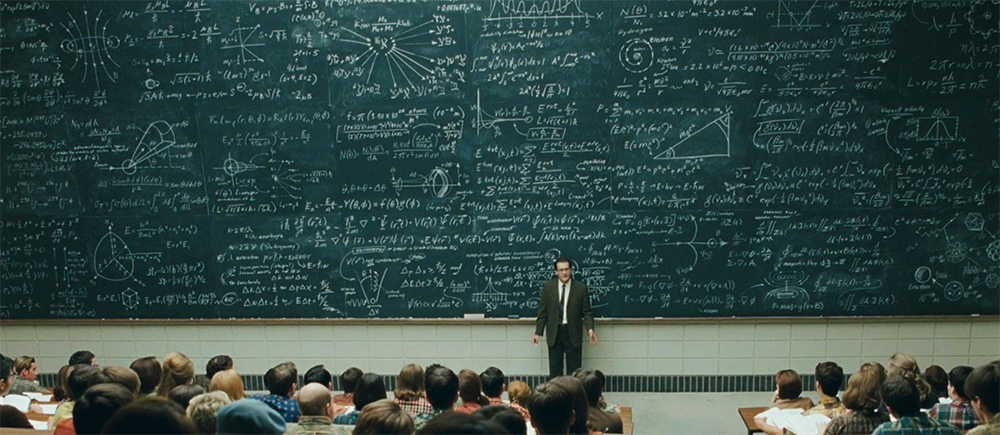Formulas on Habré

We suggest you look at a selection of beautiful (and not very) in the opinion of mathematicians formulas, and at the end of the publication - a small bonus.
The most "beautiful" flourish was the Euler identity, which is a consequence of the Euler formulas connecting the exponent of a complex number with trigonometric functions. What a beauty!
1+ei pi=0
The second place in the charts went to the main trigonometric identity, connecting two main trigonometric functions:
cos2 theta+ sin2 theta=1
And how do you find the Gauss-Bonnet Formula? Bukovka to bukovka!
')
intMKdA+ int partialMkgds=2 pi chi(M)
Well, or Gaussian integral (also known as Euler-Poisson integral). From the beauty already captures the spirit!
int − inftyinftye−x2dx= sqrt pi
But the "ugly" according to scientists Formula Ramanujan. Well, scared, as if the cat piled!
frac1 pi= frac2 sqrt29801 sum inftyk=0 frac(4k)!(1103+26390k)(k!)43964k
And in this line is created complete chaos:
lim8 rightarrow9 sqrt8=3
sum inftyn=1anzn and sum inftyn=1 frac1anzn
sum inftyn=1an and sum inftyn=1 frac1an converges
liman=0, lim frac1an=0
limsup sqrt[n]|an|=l= frac1R
frac1liminf sqrt[n]|an|= frac1l′
frac1R= limsupn to infty sqrt[n] lvertan rvert geqslant liminfn to infty sqrt[n] lvertan rvert= frac1 limsupn to infty sqrt[n]1/ lvertan rvert= frac11/R=R.
\ frac {1} {\ sqrt {a ^ 2 + ab + b ^ 2}} + \ frac {1} {\ sqrt {a ^ 2 + ac + c ^ 2}} + \ frac {1} {\ sqrt {b ^ 2 + bc + c ^ 2}} \ geq \ frac {2} {\ sqrt {ab + ac + bc} + \ sqrt {\ frac {a + b + c} {3 (a ^ 3 + b ^ 3 + c ^ 3)}}
left( sum limitscyc sqrt[3]a2+4bc right)3 sumcyc(a2+4bc)3(ka+b+c)4 geq left( sum limitscyc(a2+4bc)(ka+b+c) right)4
left( sum limitscyc(a2+4bc)(ka+b+c) right)4 geq45(ab+ac+bc) sumcyc(a2+4bc)3(ka+b+c)4,
a4+b4+c4+d4+a2b2+b2c2+c2d2+d2a2+8(1−a)(1−b)(1−c)(1−d) geq1
And many of you have probably heard this story. At the beginning of the 70s of the last century, the company Parker issued an advertisement in which a hand was drawn, writing with a pen some formula:
frac3.5G+ fracV24(H2O)3+3(360 circ)=M
The company management then received a lot of questions from chemists, physicists and other scientists with a request to clarify what was written, they say, what kind of a formula ?! It turned out that this is nothing but a comic martini recipe, which should be read as follows: take 3.5 parts of gin and 0.5 vermouth, add 4 ice cubes and shake with three movements.
Friends, as you probably already understood, we added support for mathematical formulas to the site - both beautiful and not so. To do this, we use the LaTex markup language (in the desktop version, the MathJax library is used to draw the formulas on the page, the mobile version, the mobile application, and the RSS formulas are displayed using SVG).

To add a formula to a publication, click the Σ icon in the toolbar. In the window that appears, select the lower case or block type of formula.
- the line formula is used to insert a formula in a paragraph of text;
- block formula is used to insert a formula from a new line.
After making the formula, click on the “Add Formula” button and it will appear in the text of the publication.
Formulas can be colored and made headings. Here, for example, is the Einstein-Pythagoras formula:
E=m cdotc2=m cdot(a2+b2)
Formulas work only in publications, there is no support for formulas in the comments yet.
Also do not forget that Habré has the opportunity to insert various oembed-objects, as we have already told . And, perhaps, someone missed the post about the design of publications .
Source: https://habr.com/ru/post/319600/
All Articles